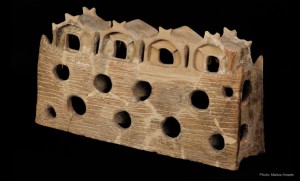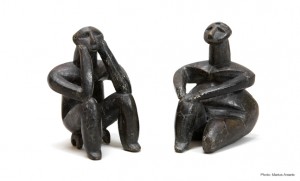 “Old Europe” is a term for a group of interrelated cultures farming the Danube Valley between 5000 and 3500 B.C in what are now Romania, Bulgaria and Moldavia. They built heavily, some of the towns developing into cities of 10,000 people. Despite their impressive architectural, ceramic and metallurgic skills Old Europeans haven’t been studied much in the West.
“Old Europe” is a term for a group of interrelated cultures farming the Danube Valley between 5000 and 3500 B.C in what are now Romania, Bulgaria and Moldavia. They built heavily, some of the towns developing into cities of 10,000 people. Despite their impressive architectural, ceramic and metallurgic skills Old Europeans haven’t been studied much in the West.
Artifacts were first discovered in the late 19th century, but only excavated systematically in the 30’s. Then the war and Cold War kept Old Europe out of reach of Western scholars. It was barely known at all until some collaborative excavations began in the 1990s.
Now 250 Old European objects of ceramics, jewelry, religious statuary, etc. from over 20 museums across the Danube Valley have traveled to New York and are on display in New York University’s Institute for the Study of the Ancient World.
Archaeologists also know that Old Europeans had metallurgy—in fact, of copper artifacts dating earlier than 3500 BC, five tons were recovered from this area—more than what has been found in the rest of the Old World, according to guest curator Dr. David Anthony.
Metallurgy is what set off the development of this society, Anthony said. He theorizes that because metallurgy and ceramics share the same basis in pyrotechnology, it was women who discovered metallurgy. “In most of the prehistoric tribal cultures around the world, ceramics made for household consumption … are made by women—and so it was probably women, female potters, who discovered metallurgy. We normally think of metallurgy as being conducted by large, hairy-chested, sweating men.”
 I don’t know about that. The large number of female figurines found has led some people to believe that Old Europeans may have been matriarchal or structured in some way that emphasizes female leadership, but the civilizations were pre-literate, and there are copious mother figurines extant from many Neolithic cultures.
I don’t know about that. The large number of female figurines found has led some people to believe that Old Europeans may have been matriarchal or structured in some way that emphasizes female leadership, but the civilizations were pre-literate, and there are copious mother figurines extant from many Neolithic cultures.
Nobody knows exactly what happened to this highly skilled, quasi-urban civilization. They seem to have disappeared quickly, leaving behind structures burned to the ground. At first archaeologists thought the fires were the result of war and/or natural causes, but recent analysis has found evidence of vitrified clay in the walls of these buildings. It takes an enormous amount of heat for the sand in clay to turn to glass, so that suggests deliberate arson beyond a few torches and flaming arrows, like maybe the inhabitants stuffed their houses with accelerants and lit them up. Maybe as a ritual purification thing, maybe a hundred other possible reasons.
Read more about Old Europe and the artifacts on display on the exhibition website.